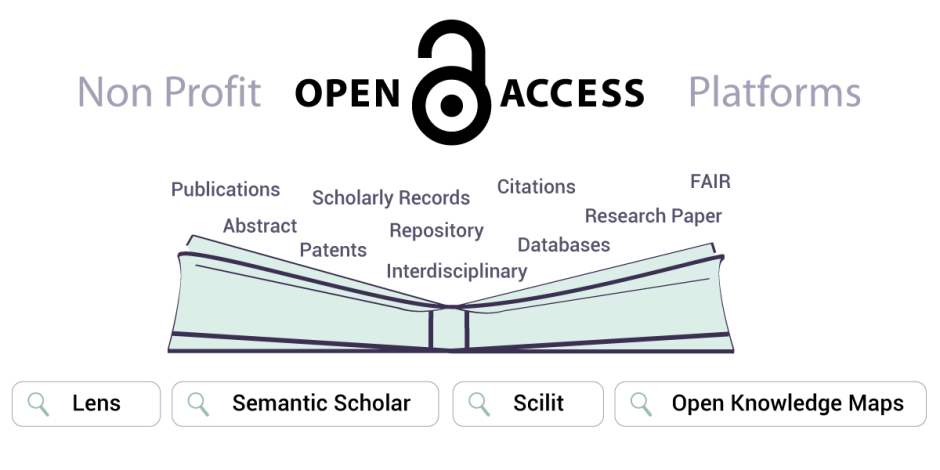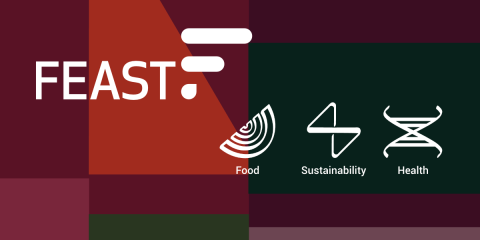
As humans, we thrive to make our lives easy and with Google in place, we are half-way through finding solutions to almost all our hardships. However, finding millions of solutions on the internet is not always a blessing. Sorting the results that best serve the problem is a tedious task. For researchers, this time-taking process of finding the most relevant idea on the internet is an everyday saga. On top of it, several resourceful platforms charge expensive fees owing to their intellectual property laws.
In this blog, we have compiled a few Open Access (OA) knowledge platforms offered by the non-profit organizations, which are taking over the internet with their free, secure, and transparent approaches. The aim of this article is not to evaluate these platforms, but rather to give an overview on the availability of different research platforms.
1. Semantic Scholar
In the modern-day society, the longing of accuracy, speed, and precision has almost made Artificial Intelligence (AI) an integral part of our lives. Inspired by the power of AI, several creative research platforms have come into existence with novel approaches to help scholars achieve the desired solutions. One of such dynamic platforms is Semantic Scholar. Launched in 2015, Semantic Scholar is a free, AI-powered research platform for scientific literature, owned by The Allen Institute for Artificial Intelligence, a non-profit research institute facilitating high-impact AI research. The primary objective of Semantic Scholar is to overcome information overload on the researchers and removing long tail of search results using automated learning from the texts.
The platform offers over 207 million papers from diverse field of science with a record of around 79 million authors and 2.5 billion citations. Thanks to AI, despite having such an extensive database, the researchers get directly relevant results of their research in lesser times when compared to those offered by the close competitors. Fascinating features such as TLDRs (Too Long; Didn't Read) help this platform to stand out in the crowd. TLDRs use expert background knowledge and NLP techniques to generate short summaries for over 60 million papers in the field of medicine, biology, and computer science. This saves time for the researchers as well as prevent them in getting into a loop of long tail of search results.
Furthermore, the researcher can take the advantage of Highly Influential Citations, a product based on the machine-learning model, which analyses several factors including the number of citations to a publication to determine the influential citations, which can have a significant impact on the cited publication. In addition to all these features, the platform also offers an online library to the users to organize their papers and facilitate their search results. The online library has AI-powered Research Feeds, which generate regular paper recommendations for the users. Furthermore, the platform also offers Semantic Scholar Academic Graph API, which allows researchers to extract data about citations, papers, authors, etc. This accelerates search capabilities and paper discoveries.
The potential of semantic scholar is as endless as its user demands. As a researcher, we already have a lot on plate. With AI and ML driven models, it’s worth experiencing a smarter way to search and discover results while saving some time for us to challenge ourselves in exploring other possibilities.
Know more about Semantic Scholar and it's offerings at https://www.semanticscholar.org/
2. Lens
When we look for Open Access data, we expect transparency, reliability, and a free platform with no hidden paywalls. The Lens fits all these filters of expectations quiet well and it’s a perfect alternative to closed, proprietary services. It is an extension of work started by Cambia, a non-profit social enterprise, to render the global patent system more transparent, called the Patent Lens. Since then, in addition to patent search, it has increased its functionality to scholarly search, profile search, sequence search, and many others. It is a great substitute to its competitors as it offers a powerful blend of search and analysis filters, data visualization capabilities, as well as bulk export functions, among several other features.
The platform has over 256 million scholarly records with 51.2 million open access scholarly works sourced from databases, such as PubMed, CrossRef, Microsoft Academic, OpenAlex, and others. Since it started as a patent search tool a decade ago, it has a strong database for patent records. It serves 147 million patent records from over 106 different jurisdictions. As of now, over 17 million patent applicants, 1.6 million patent owners, and 83 million patent families can be searched in the Lens.
The filters in Lens are extremely intensive, which makes it more than just a literature discovery tool. The scholarly search does not just stop at advanced search with date range, author name, type of article, and relevance sort; but it allows the researchers to filter by affiliation, identifier type, funding institutes, subject matter, and many other levels. Such extensive range of filters are not available in other platforms (at least not without a “Freemium” offer).
Although the platform is absolutely free for open public access and non-profit applications, it offers different pricing options for commercial users and enterprises. More features are available to the users, both non-profit as well as commercial users, who are registered at the platform. For instance, the platform allows the registered users to create powerful visualizations and dashboards, to access their saved queries and collection of works, media library, and many more. Moreover, over 1000 search results can be bulk exported at once. Several such attractive features make Lens one of the most widely used research platforms.
To enlighten yourself more on the features that this platform offers, please visit https://www.lens.org/
3. Scilit
As concluded by the name, Scilit is an Open Access database, which combines science and literature on one platform. This free and comprehensive content aggregator platform is developed and maintained by open access publisher MDPI. The content aggregation approach of the platform allows the coverage of new publications within hours. It uses bibliographic big data analysis to provide insights to the latest trends in academia to its users. The primary aim of the platform is to make research outputs more accessible to researchers, industry partners, policymakers, and other interested parties as quickly as possible.
As of now, the database has over 157 million scholarly publications from around 18 thousand publishers. Out of these publications, over 32 million are Open Access. The overall citation recorded at the platform is around 1.2 billion. About 16 million scholars with great expertise in their fields can be found on the platform with in-depth information about their index, cites, and number of contributed journals, along with their profiles on SciProfiles, Google Scholar, and ORCID.
The platform offers different features and tools to make the journey of the user on the platform more informative and easier. For instance, relevant filters to publishers can be found, such as those offering Open Access articles are available for the users to narrow down their search. A detailed analysis of a publisher including analysis of the total number of journal articles published per year, citations per year, publication types offered by the publisher, and top countries where the publications are published, are available, which allows the user to get a detailed insight on different publishers.
Similar analyses are available for each organization, scholar, and source found on the platform. For authors, the platform offers citations alert service, which notifies them about the citation of their publication by newly published articles. Likewise, the SciFeed alert service notifies a registered user about any newly published article matching a customized query.
Although the filters a not as extensive as other platforms mentioned in this blog, they are sufficient to get the relevant research results. Most importantly, the detailed analysis dashboards for different sources, publishers, scholars, and organizations make it distinctive and highly informative. Overall, the platform is simple and easy to use.
4. Open Knowledge Maps
Open Knowledge Maps is an innovative and valuable platform that provides an alternative approach to discovering and navigating scholarly research. It aims to overcome the limitations of traditional search methods by offering visual knowledge maps, which present an organized overview of research topics and related publications. One of the key strengths of Open Knowledge Maps is its emphasis on Open Access content. The platform primarily relies on openly available resources, including Open Access journals, preprints, and institutional repositories, which allows users to access a broad range of research without encountering paywalls or subscription barriers. This commitment to openness promotes transparency and facilitates equitable access to knowledge.
The visual knowledge maps offered are intuitive and user-friendly. They provide an interactive and graphical representation of a research topic, highlighting key concepts, subtopics, and relevant publications. This visual approach helps researchers grasp the landscape of a field quickly, identify important works, and explore connections between different research areas. It can be particularly beneficial for individuals who are new to a topic or seeking interdisciplinary perspectives. In addition to the knowledge maps, Open Knowledge Maps also integrates with various external platforms and databases, such as PubMed and BASE, to provide a comprehensive search experience. Users can retrieve detailed information about specific publications, access full-text articles, and export references in various citation formats.
Open Knowledge Maps actively encourages community collaboration and engagement. The platform allows users to create and share their own knowledge maps, fostering a collective effort in curating and organizing research information. This collaborative aspect promotes the development of interdisciplinary connections, facilitates the exchange of ideas, and encourages the reuse and remixing of knowledge maps for different purposes.
Despite its many strengths, it is worth noting that Open Knowledge Maps may not cover the entirety of the scholarly literature landscape. The platform relies on openly available resources, which might not encompass all research articles and journals. Therefore, researchers may need to supplement their searches with other databases and resources to ensure comprehensive coverage.
Overall, Open Knowledge Maps is a valuable tool that offers a fresh and visual approach to exploring scholarly research. Its commitment to Open Access, user-friendly interface, and collaborative features make it a useful resource for researchers, students, and anyone interested in discovering and mapping the landscape of scientific knowledge.
Our next research article will focus on OA platforms offered by for-profit organizations. Stay tuned!
Image source: os4os


